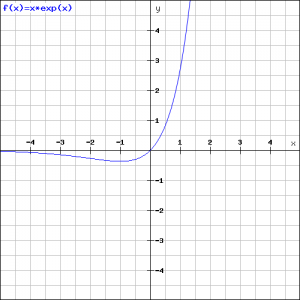Summary and examples
![]() is the derivative of a function
is the derivative of a function ![]() in a point
in a point ![]() and is the slope of the tangent line at that point of the graph of that function.
and is the slope of the tangent line at that point of the graph of that function.
When ![]() it means that the tangent line in
it means that the tangent line in ![]() has a slope
has a slope ![]() and thus that it is horizontal to the
and thus that it is horizontal to the ![]() -axis. For such a point there are three possibilities:
-axis. For such a point there are three possibilities:
- the point is a (local) maximum;
- the point is a (local) minimum;
- the point is a horizontal inflection point (an example is the graph of
 ).
).
When we want to know in which points a function ![]() has a local maximum, minimum or horizontal inflection point, we calculate the derivative
has a local maximum, minimum or horizontal inflection point, we calculate the derivative ![]() and try to find for which values
and try to find for which values ![]() , for these values of
, for these values of ![]() the derivative equals zero and the tangent line is horizontal.
the derivative equals zero and the tangent line is horizontal.
Example 1
Determine the minimum of the parabola:
![]()
We already know that this parabola 'opens up' (the coefficient of the square equals ![]() and thus
and thus ![]() ) and thus has a minimum that lies on the symmetry-axis, see Quadratic functions and graphs.
) and thus has a minimum that lies on the symmetry-axis, see Quadratic functions and graphs.
We differentiate the function and get:
![]()
and thus:
![]()
The parabola has a minimum in the point ![]() .
.
Example 2
Quadratic functions (the graphs are parabolas):
![]()
have a maximum or minimum that lies on the symmetry-axis:
![]()
We can also calculate this by differentiation. The derivative of the function above is:
![]()
The derivative is equal to ![]() when:
when:
![]()
which is the ![]() -coordinate of the top.
-coordinate of the top.
The values of ![]() for which the derivative of the function equals
for which the derivative of the function equals ![]() are candidates for a maximum, minimum or horizontal inflection point, but we do not know yet which of the three is the case. This requires further investigation. There are two different methods for this.
are candidates for a maximum, minimum or horizontal inflection point, but we do not know yet which of the three is the case. This requires further investigation. There are two different methods for this.
Method 1: consider the sign of the first derivative
The derivative of a maximum in a point ![]() is equal to
is equal to ![]() .
.
Left to the maximum the function is increasing and thus ![]() for
for ![]() .
.
Right to the maximum the function is decreasing and thus ![]() for
for ![]() .
.
So the sign of the first derivative ![]() around the maximum
around the maximum ![]() has the following signs:
has the following signs:
maximum : + ![]() -.
-.
Similarly, the sign of the first derivative ![]() around the minimum
around the minimum ![]() has the following signs:
has the following signs:
minimum: - ![]() +.
+.
For a horizontal inflection point we find similarly:
horizontal inflection point : + ![]() + or -
+ or - ![]() -.
-.
Method 2: consider the 2nd derivative
When ![]() is one of the solutions of the equation
is one of the solutions of the equation ![]() it is a candidate for a maximum, minimum or horizontal inflection point. Then the following holds.
it is a candidate for a maximum, minimum or horizontal inflection point. Then the following holds.
If:
![]() , then
, then ![]() is a minimum;
is a minimum;
![]() , then
, then ![]() is a maximum;
is a maximum;
![]() , then
, then ![]() is a horizontal inflection point.
is a horizontal inflection point.
Example 3
Check whether the function:
![]()
has a maximum and/or a minimum.
The derivative is:
![]()
The derivative equals ![]() if:
if:
![]()
so if:
![]() or
or ![]()
The corresponding points on the graph are, respectively:
![]() or
or ![]()
Now we check both methods.
Method 1
Around ![]() we find the following signs of
we find the following signs of ![]() :
:
+ ![]() - and thus there is a maximum.
- and thus there is a maximum.
Around ![]() we find the following signs of
we find the following signs of ![]() :
:
- ![]() + and thus there is a minimum.
+ and thus there is a minimum.
Method 2
We have to calculate the second derivative:
![]()
Then:
![]() and thus the function has a maximum for
and thus the function has a maximum for ![]()
and
![]() and thus the function has a minimum for
and thus the function has a minimum for ![]()
Example 4
Check whether the function:
![]()
has a local maximum or minimum.

The derivative of the function is, using the product rule:
![]()
The derivative equals ![]() when
when ![]() and thus the point
and thus the point ![]() is a candidate for either a maximum or minimum. Further research should reveal which of the two it is. It is even possible that it is a point of inflection.
is a candidate for either a maximum or minimum. Further research should reveal which of the two it is. It is even possible that it is a point of inflection.
We can use either method, but the second method is more laborious because then we need to use the production rule again. Therefore we take method 1 and only need to consider the sign of ![]() because the exponential function
because the exponential function ![]() is always positive.
is always positive.
If ![]() then
then ![]() is negative and if
is negative and if ![]() then
then ![]() is positief and thus we have a minimum, see the figure.
is positief and thus we have a minimum, see the figure.
Example 5
Investigate the function:
![]()
We calculate the derivative:
![]()
The equation:
![]()
has ![]() as a solution which is a candidate for a maximum, minimum of horizontal inflection point.
as a solution which is a candidate for a maximum, minimum of horizontal inflection point.
The second derivative is:
![]()
which is equal for ![]() . So the point
. So the point ![]() is a horizontal inflection point.
is a horizontal inflection point.

